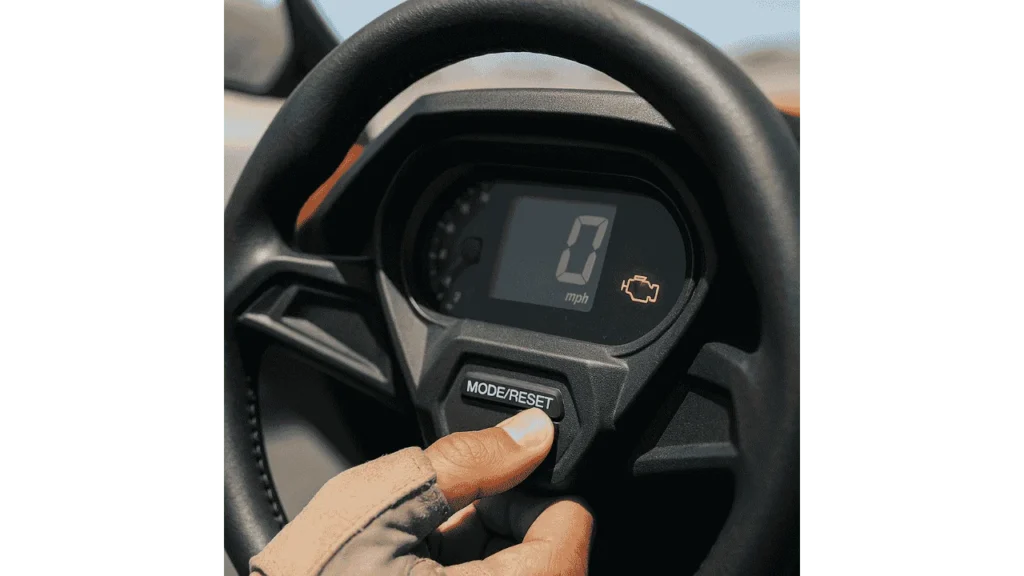As a powersports diagnostics specialist, I often remind riders that the check engine light is not just an annoyance; it’s a built-in warning system designed to protect your engine and performance. On a Polaris Slingshot, it typically signals a sensor error, emissions imbalance, or a minor system hiccup. Resetting this light should only be done after confirming the underlying cause is either harmless or fully resolved. In the sections below, we’ll break down the reasons this light appears, when it’s safe to reset, and exactly how to clear it without compromising vehicle integrity.

Understanding the Check Engine Light
The check engine light on the Polaris Slingshot is part of its onboard diagnostics (OBD-II) system. It’s programmed to illuminate when something in the engine, emissions, or electrical system operates outside of normal parameters. While many causes are minor, like a loose gas cap or temporary sensor fault, others may indicate the early signs of real mechanical issues. Clearing the code without understanding it can delay needed repairs or mask problems that affect reliability.
Common Causes of the Check Engine Light
Loose Gas Cap
One of the simplest culprits, a gas cap that isn’t fully sealed can disrupt the fuel system’s pressure, prompting a warning. After securing it, the light may turn off on its own after a few drive cycles.
Sensor Issues
Faulty oxygen or mass airflow sensors are common triggers. These sensors help manage fuel and emissions and may misreport data if contaminated or aging.
Emissions Faults
A failing catalytic converter or evaporative system fault can also activate the light. These problems usually require deeper inspection and may cause performance dips.
When Should You Reset the Light?
Resetting the check engine light is appropriate only after resolving the root cause. For example, tightening the gas cap or topping off low fluid levels may clear the code. But if the Slingshot is running rough, making unusual sounds, or the light returns immediately, further diagnostics are necessary. As performance technician Greg Thomas notes,
“A reset is a confirmation, not a solution. You’re only done once the code stays cleared after a few ride cycles.”
Steps to Reset the Check Engine Light on a Polaris Slingshot
Step 1: Inspect for Obvious Issues
Look for visible problems first: ensure the gas cap is sealed, fluid levels are normal, and no warning indicators show on the display.
Disconnect the Battery to Clear Codes
To begin, make sure the ignition is completely off and allow the vehicle to cool. Locate the battery, which is typically housed in the engine compartment for easy access. Using a wrench, remove the negative terminal cable and let the system sit idle for 10–15 minutes. This pause gives the control module time to clear any stored diagnostic fault codes. Once time has passed, reconnect the terminal, secure the bolt firmly, and restart the vehicle. If the cause of the error has been corrected, the check engine light should remain off.
Using an OBD-II Scanner for a Controlled Reset
Locate the OBD-II diagnostic port beneath the dashboard. With the ignition switched on but the engine still off, plug in the scanner and allow it to communicate with the vehicle’s ECU. From the menu, select the option to read diagnostic trouble codes. If you’ve resolved the issue, choose the clear/reset option. After this step, start the engine and observe the instrument cluster. If the reset was successful, the check engine light should no longer appear.
Using a scanner is more accurate than disconnecting the battery and doesn’t affect radio presets or other memory settings.
Preventing Future Check Engine Warnings
Stick to Routine Maintenance
Keeping up with oil changes, air filter replacements, and scheduled inspections prevents many light-triggering issues.
Use Quality Fuel
Low-grade fuel may cause incomplete combustion or sensor fouling. Always stick to the manufacturer’s recommended octane rating.
Monitor Sensor Health
Sensors like the O2 and MAF can fail gradually. Cleaning or replacing them before they trigger a code ensures smoother performance.
When to Seek Professional Help
If the check engine light returns immediately after reset, or the vehicle shows signs of power loss, stalling, or hard starting, it’s time for expert diagnostics. Multiple stored codes or irregular drive behavior typically mean deeper system issues. Powersports engineer Jillian Reyes advises,
“Resetting the light without addressing chronic faults is like clearing your inbox without reading the messages; sooner or later, something critical gets missed.”
Final Takeaways
Resetting your Polaris Slingshot’s check engine light is simple, but it’s not a shortcut; it’s a step you take after resolving the cause. A quick battery disconnect or OBD-II scan can clear the light, but only lasting fixes keep it off. Stick to regular maintenance, respect the warning system, and don’t hesitate to consult a technician when needed. In a machine designed for performance and thrill, keeping your dashboard clear means keeping the experience smooth, reliable, and safe.





